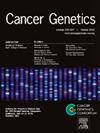Development and multi-cohort validation of a prognostic risk score model for oral squamous cell carcinoma based on a three-gene signature
IF 2.1
4区 医学
Q4 GENETICS & HEREDITY
引用次数: 0
Abstract
Background
Oral squamous cell carcinoma (OSCC) carries substantial mortality despite surgery-based management. Reliable biomarkers and practical prognostic tools are needed to guide individualized care.
Methods
Transcriptomic and clinical data from TCGA and multiple GEO cohorts were integrated. Candidate genes identified by differential expression analysis, WGCNA, and PPI were refined using LASSO and Random Forest, then entered a multivariable Cox model to derive a three-gene risk score. Performance was assessed with Kaplan–Meier curves, time-dependent ROC, and calibration, and validated across internal, external, and combined datasets. Expression was examined by RT-qPCR and Western blot in OSCC and normal oral cell lines. Immune infiltration and pathway enrichment analyses were conducted to contextualize biology.
Results
The three-gene signature (CXCL12, PLAU, PXDN) separated risk groups in the training cohort with 1/3/5-year AUCs of 0.767/0.625/0.714. In three independent external cohorts, high-risk patients consistently had worse overall survival (log-rank p = 0.0092, ≤0.0001, ≤0.0001), with time-AUC ranges of 0.581–0.747 (1-year), 0.555–0.795 (3-year), and 0.603–0.812 (5-year). In TCGA, the score remained prognostic across sex, age, smoking, drinking, and stage III/IV subgroups (all p ≤ 0.05), with a consistent trend in stage I/II (p = 0.09). A nomogram integrating clinical variables with the risk score achieved a C-index of 0.63 with good 1–5-year calibration and outperformed TNM staging alone (C-index 0.63 vs 0.58; 95 % CI 0.58–0.70 vs 0.54–0.61). RT-qPCR/Western blot confirmed consistent differential expression of all three biomarkers. Immune-infiltration and pathway analyses revealed distinct microenvironmental and molecular features across risk strata.
Conclusion
We present a robust, externally validated three-gene prognostic model for OSCC, supported by experimental evidence and superior to TNM staging for discrimination, offering a practical nomogram for individualized risk estimation from 1 to 5 years.
基于三基因标记的口腔鳞状细胞癌预后风险评分模型的开发和多队列验证
背景:尽管手术治疗,口腔鳞状细胞癌(OSCC)的死亡率仍然很高。需要可靠的生物标志物和实用的预后工具来指导个体化护理。方法整合来自TCGA和多个GEO队列的转录组学和临床数据。通过差异表达分析、WGCNA和PPI鉴定的候选基因使用LASSO和Random Forest进行细化,然后进入多变量Cox模型,得出三基因风险评分。通过Kaplan-Meier曲线、随时间变化的ROC曲线和校准进行评估,并通过内部、外部和联合数据集进行验证。用RT-qPCR和Western blot检测OSCC和正常口腔细胞株的表达。免疫浸润和途径富集分析进行了背景生物学。结果三基因标记(CXCL12, PLAU, PXDN)分离了训练队列的风险组,1/3/5年auc为0.767/0.625/0.714。在三个独立的外部队列中,高危患者的总生存率均较差(log-rank p = 0.0092,≤0.0001,≤0.0001),时间auc范围为0.581-0.747(1年),0.555-0.795(3年)和0.603-0.812(5年)。在TCGA中,评分在性别、年龄、吸烟、饮酒和III/IV期亚组中仍具有预测作用(均p≤0.05),在I/II期中趋势一致(p = 0.09)。综合临床变量和风险评分的nomogram C-index为0.63,具有良好的1 - 5年校准效果,优于单纯的TNM分期(C-index 0.63 vs 0.58; 95% CI 0.58 - 0.70 vs 0.54-0.61)。RT-qPCR/Western blot证实了这三种生物标志物的一致差异表达。免疫浸润和途径分析揭示了不同风险层的微环境和分子特征。结论我们提出了一个可靠的、外部验证的OSCC三基因预后模型,该模型有实验证据支持,在区分方面优于TNM分期,为1 - 5年的个体化风险估计提供了一个实用的nomogram。
本文章由计算机程序翻译,如有差异,请以英文原文为准。
求助全文
约1分钟内获得全文
求助全文
来源期刊

Cancer Genetics
ONCOLOGY-GENETICS & HEREDITY
CiteScore
3.20
自引率
5.30%
发文量
167
审稿时长
27 days
期刊介绍:
The aim of Cancer Genetics is to publish high quality scientific papers on the cellular, genetic and molecular aspects of cancer, including cancer predisposition and clinical diagnostic applications. Specific areas of interest include descriptions of new chromosomal, molecular or epigenetic alterations in benign and malignant diseases; novel laboratory approaches for identification and characterization of chromosomal rearrangements or genomic alterations in cancer cells; correlation of genetic changes with pathology and clinical presentation; and the molecular genetics of cancer predisposition. To reach a basic science and clinical multidisciplinary audience, we welcome original full-length articles, reviews, meeting summaries, brief reports, and letters to the editor.
 求助内容:
求助内容: 应助结果提醒方式:
应助结果提醒方式:


